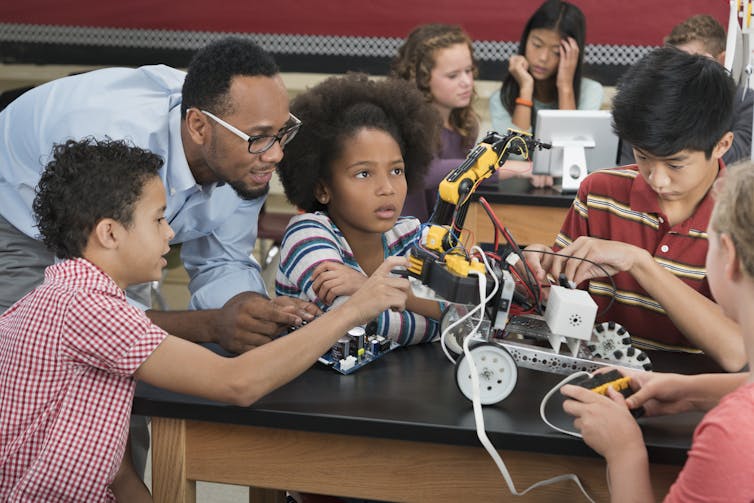How autism rates are rising – and why that could lead to more inclusive communities
- Autism rates are rising in the US, with 1 in 31 children diagnosed by age 8, up from 1 in 36 in 2023, according to the CDC.
- The diagnostic definition of autism spectrum disorder has expanded over time to include a wider variety of symptoms, leading to more diagnoses and a better understanding of the condition’s impact on individuals and communities.
- Autism affects children regardless of race, ethnicity, or income level, with varying prevalence rates across different locations in the US, including California (1 in 19) and Texas (1 in 103-51).
- The shift towards more accurate diagnoses of autism in girls is attributed to a growing understanding that autism looks differently in females, allowing clinicians to identify it in larger numbers.
- Rather than being a cause for fear, the rising recognition of autism presents an opportunity to build inclusive communities and support individuals with autism in their personal and professional lives through accommodations, training programs, and policies.

I can say from personal experience that being diagnosed with autism spectrum disorder can feel very isolating. Increasingly, however, it’s not unusual.
In the U.S., 1 in 31 children are diagnosed with autism each year by age 8, according to the latest data from the Centers for Disease Control and Prevention. That number, released in April 2025, is up from 1 in 36 in 2023.
These statistics have been widely characterized as concerning. But I would like to offer a different perspective.
I am a researcher studying how young people with autism transition to adulthood. I also work on the Autism and Developmental Disabilities Monitoring Network, which was established by the CDC two decades ago to determine the prevalence of autism in the U.S. and which produced the 2025 report.
Additionally, this topic is deeply personal to me, since I am diagnosed with Asperger’s syndrome, now known as autism spectrum disorder.
While autism does present challenges, my professional and personal experiences have taught me that creating space for autistic people’s perspectives affords opportunities for making the world a more vibrant place.
A rare condition?
Autism spectrum disorder is a developmental condition that manifests differently from person to person but commonly affects how a person communicates, socializes and interacts with the world.
In the 1990s, researchers and clinicians estimated that autism was a relatively rare condition, affecting an estimated 1 in 500 children. But the real-world experiences of families and clinicians suggested that it was more common.
In a landmark study published in 1998, researchers examined autism prevalence in a community in New Jersey to determine a more realistic estimate in the U.S. population. They found that approximately 1 in 150 children had autism – making it more than three times more common than previously believed.
Then, in 2000, the newly formed Autism and Developmental Disabilities Monitoring Network, which set out to study autism among 8-year-olds, looked across a much broader population and confirmed the higher prevalence.
A growing recognition
Since then, the number of children recognized as having autism by a doctor or an education specialist has continued to rise. The 2025 report shows that autism occurs in all types of communities. Autism affects children regardless of race, ethnicity or income level.
Autism prevalence does vary by location, though. It is highest in California, where it is recognized in around 1 in 19 children, and lowest in Texas, where the prevalence ranges from around 1 in 103 to 1 in 51 children. In Arizona, where I live and work, the prevalence is around 1 in 32, which is very close to the CDC’s overall nationwide estimate.

Ariel Skelley/DigitalVision via Getty Images
Researchers believe that this wide geographic variability in autism prevalence reflects complex interactions between community awareness and acceptance, the availability of clinical and education services in schools and communities that serve people with autism, broader culture acceptance of mental health challenges, and other societal factors.
The number of autism diagnoses also varies by gender. One well-known feature of autism is that it affects boys more often than girls. In the late 1990s and early 2000s, four boys for every one girl was diagnosed with autism. This disparity persisted for many years. But now, it seems to be shrinking: In the May 2025 data, the ratio for boys versus girls is 3.4 to 1.
This shift reflects the growing understanding that autism looks different in girls than in boys, which in turn allows clinicians to accurately identify it in girls in larger numbers.
From recognition to acceptance
Research shows, however, that this increase in autism diagnoses is not something to fear.
While some children diagnosed with autism are profoundly affected and require significant support, many others successfully engage in everyday activities like school, sports and work. One 2022 study found that a majority of children reported as having autism by their parents expect to attend college. This suggests that many people diagnosed with autism feel they are capable of living full and productive lives.
Of course, understanding the patterns of autism prevalence does not explain why it occurs in the first place. Research suggests that genes are a major cause of autism. But many things have changed over the past several decades since researchers and clinicians began tracking autism occurrence. For example, the criteria clinicians use to diagnose autism have changed over time to become less restrictive.
Today, a wider variety of symptoms are included in the diagnostic definition of autism spectrum disorder than when autism was first introduced as a mental health condition in 1980.
Another change is that autism is much more widely accepted in society than it was just a decade ago. For example, autistic characters are often portrayed in media as protagonists that the audience is cheering for. This growing recognition and acceptance is associated with an increase in self-diagnosis of autism.
Building richer communities
While autistic people tend to have some unique challenges, including repetitive behaviors, restricted interests and social communication difficulties, they also have particular strengths, such as creative, out-of-the-box thinking. For me, this includes seeing connections that others miss.
Autistic people report that their unique perspective offers specific benefits in their workplaces and careers. Many go on to make important contributions to their communities and to shape society as a whole.
For example, Temple Grandin, an outspoken author and speaker on autism and a professor of animal science at Colorado State University, has credited her autism with influencing her research on animal handling and animal behaviors. Comedian Dan Aykroyd, who was an original cast member and host of “Saturday Night Live”, credits his diagnosis of Asperger’s syndrome and fixation on ghosts for developing the movie “Ghostbusters”.
A more complete picture of autism that includes strengths as well as challenges creates a starting point for building communities that are inclusive and accepting of autistic people. From there, policymakers, employers and others can start to create dynamic and vibrant places where people with autism can successfully live, work and play alongside their nonautistic peers.
And, given that children with autism will become adults with autism, it allows experts like me to identify needs and design policies that help communities support autistic people at different stages of their life.

Maskot/DigitalVision via Getty Images
For example, the growing number of students with developmental challenges raises demands on special education services. This means state and local education systems may need to develop and implement specialized training programs for educators to better support autistic students in the classroom.
Autistic children who need accommodations in school may also need support to succeed in adulthood. This can range from having physicians who gear their clinical practices to better listen to autistic patients to work-from-home and other accommodations that encourage engagement with traditional employment.
Broader frameworks such as laws and policies can also help attune workplaces and other environments to the needs of people with autism. For example, independent living programs and programs that train, hire and retain workers with disabilities can ensure the economic success of people with autism.
Cities can also become autism certified, a process that brings together community stakeholders in health care, education, local government, hospitality and leisure to better serve those with autism. This includes training on how to interact with people who have cognitive differences as well as creating sensory-friendly environments. The city that I live in – Mesa, Arizona – was the first to gain such certification in 2019, and a handful of other cities have followed suit.
As I see it, rather than a cause for fear, the growing recognition of autism is an invitation to build a world where every way of thinking and being has a chance to thrive.
![]()
Joshua Anbar receives funding from the Centers of Disease Control and Prevention. He is member of the Self-Advocate Advisory Board at the Southwest Autism Research and Resource Center (SARRC), where he also completed his postdoc work.
